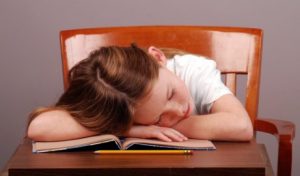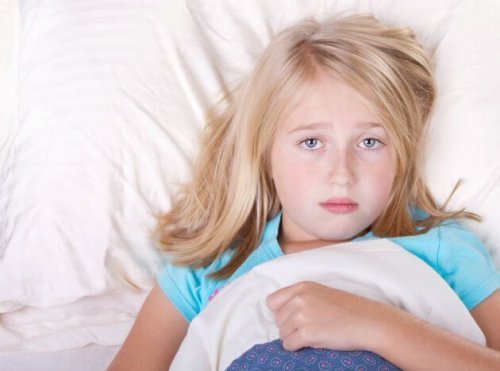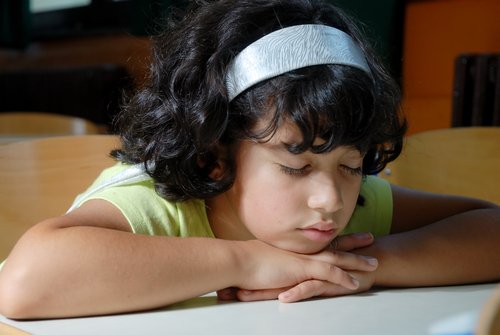Hypersomnia in Children: What You Need to Know

Hypersomnia is most common among teens and young adults. However, it can occur at any age, including childhood. In children between the ages of 2 and 7, hypersomnia appears in lapses of nightly sleep of more than 8 hours.
Children with hypersomnia appear sleepy and take repeated naps during the day. This happens even in the presence of peers and in the middle of activities. Sometimes, children also develop unexpected hyperactivity.
Besides unexplained tiredness, hypersomnia also causes loss of concentration, irritability, bad behavior and poor academic performance. As for adolescence, hypersomnia affects a person’s physical, psychological and emotional well-being.
Youth are unable to control their yawning and nodding. They become disoriented and develop a very aggressive character.
Types of hypersomnia in children
It’s important to differentiate between hypersomnia or excessive somnolence and simple exhaustion. When people feel weak, fatigued or depressed, they choose sleep as a way of reenergizing.
Hypersomnia, however, “forces” individuals to sleep at any time and on any occasion, whether or not the body needs it. Essentially, this disorder modifies a person’s normal sleep cycle. This leads to memory loss and lack of attention.
There are 2 types of hypersomnia:
- The first type, primary hypersomnia, originates in the central nervous system.
- The second occurs as a result of chronic sleep deprivation. This is the most common type in children and teens.
While primary hypersomnia is less common, it requires a great deal of attention. It’s caused by narcolepsy, the Klein-Levin syndrome (sleeping beauty syndrome) or idiopathic or unknown reasons.
Narcolepsy, specifically, generates a clinical case of cataplexy (muscle weakness), sleep interruption or unreal perceptions. It can cause individuals to be unable to move their extremities. It can also cause rapid eye movements and recurrent parasomnia.

What causes hypersomnia in children?
The most common cause of hypersomnia in children is chronic sleep deprivation. The is the result of changes in routine, illness, neurological conditions or primary sleep disorders.
Circadian rhythm becomes poorly adjusted when a sleep phase is advanced or delayed. The same happens when people experience sudden changes in time zone. Intense night-time activities can also affect a person’s circadian rhythm.
Hypersomnia in children is mostly a result of insufficient rest. It occurs when they spend hours watching television or on the computer or another electronic device during the night. In consequence, the time they spend resting is shorter, as they still have to wake up early to go to school.
Children with hypersomnia appear sleepy and take repeated naps during the day. This happens even in the presence of peers and in the middle of activities. Sometimes, children also develop unexpected hyperactivity.”
Another main trigger of hypersomnia, especially in children ages 2 to 6 is Obstructive Sleep Apnea. This disorder impedes breathing for a fraction of seconds during sleep, thus impeding deep rest.
Other agents that can influence the appearance of hypersomnia are the following:
- Head injury.
- Neurological diseases.
- Effects of medication.
- Excessive weight.
If the central nervous system is compromised or a person has tumors, this can lead to diagnosis. Family medical history can also lead to a diagnosis of hypersomnia.
What other issues do hypersomnia produce?
The main product of hypersomnia is excessive and uncontrollable sleepiness. Sleep alterations must be predominant for at least one month before diagnosis can be made.
This constant sleepiness also leads to other issues such as anguish, slow thinking and speaking, and lack of appetite. At the same time, children with hypersomnia may experience lack of memory and energy, as well as difficulty coping in social settings.
If hypersomnia is linked to Kleine-Levin syndrome, then individuals may sleep for more than 18 hours.

The most common treatments for hypersomnia
The first recommendation for treating hypersomnia is to observe your child’s sleep cycles and record alterations and possible risk factors. Environment and lifestyle will say a lot to parents and specialists about the complexity of the disorder.
When hypersomnia is the result of narcolepsy, children can still live a normal life as long as they get the help they need. Treatment will have to involve the support of family, teachers and classmates.
In general, hypersomnia in children, adolescents and adults requires therapeutic intervention. This can sometimes include medication. Without treatment, the condition will only worsen.
Patients can go from falling asleep frequently throughout the day to sleeping 12 to 18 hours daily. This will greatly affect their ability to interact with others and complete tasks. To keep this from happening, you can turn to bodily therapies, communication therapy and attention therapy.
Hypersomnia is most common among teens and young adults. However, it can occur at any age, including childhood. In children between the ages of 2 and 7, hypersomnia appears in lapses of nightly sleep of more than 8 hours.
Children with hypersomnia appear sleepy and take repeated naps during the day. This happens even in the presence of peers and in the middle of activities. Sometimes, children also develop unexpected hyperactivity.
Besides unexplained tiredness, hypersomnia also causes loss of concentration, irritability, bad behavior and poor academic performance. As for adolescence, hypersomnia affects a person’s physical, psychological and emotional well-being.
Youth are unable to control their yawning and nodding. They become disoriented and develop a very aggressive character.
Types of hypersomnia in children
It’s important to differentiate between hypersomnia or excessive somnolence and simple exhaustion. When people feel weak, fatigued or depressed, they choose sleep as a way of reenergizing.
Hypersomnia, however, “forces” individuals to sleep at any time and on any occasion, whether or not the body needs it. Essentially, this disorder modifies a person’s normal sleep cycle. This leads to memory loss and lack of attention.
There are 2 types of hypersomnia:
- The first type, primary hypersomnia, originates in the central nervous system.
- The second occurs as a result of chronic sleep deprivation. This is the most common type in children and teens.
While primary hypersomnia is less common, it requires a great deal of attention. It’s caused by narcolepsy, the Klein-Levin syndrome (sleeping beauty syndrome) or idiopathic or unknown reasons.
Narcolepsy, specifically, generates a clinical case of cataplexy (muscle weakness), sleep interruption or unreal perceptions. It can cause individuals to be unable to move their extremities. It can also cause rapid eye movements and recurrent parasomnia.

What causes hypersomnia in children?
The most common cause of hypersomnia in children is chronic sleep deprivation. The is the result of changes in routine, illness, neurological conditions or primary sleep disorders.
Circadian rhythm becomes poorly adjusted when a sleep phase is advanced or delayed. The same happens when people experience sudden changes in time zone. Intense night-time activities can also affect a person’s circadian rhythm.
Hypersomnia in children is mostly a result of insufficient rest. It occurs when they spend hours watching television or on the computer or another electronic device during the night. In consequence, the time they spend resting is shorter, as they still have to wake up early to go to school.
Children with hypersomnia appear sleepy and take repeated naps during the day. This happens even in the presence of peers and in the middle of activities. Sometimes, children also develop unexpected hyperactivity.”
Another main trigger of hypersomnia, especially in children ages 2 to 6 is Obstructive Sleep Apnea. This disorder impedes breathing for a fraction of seconds during sleep, thus impeding deep rest.
Other agents that can influence the appearance of hypersomnia are the following:
- Head injury.
- Neurological diseases.
- Effects of medication.
- Excessive weight.
If the central nervous system is compromised or a person has tumors, this can lead to diagnosis. Family medical history can also lead to a diagnosis of hypersomnia.
What other issues do hypersomnia produce?
The main product of hypersomnia is excessive and uncontrollable sleepiness. Sleep alterations must be predominant for at least one month before diagnosis can be made.
This constant sleepiness also leads to other issues such as anguish, slow thinking and speaking, and lack of appetite. At the same time, children with hypersomnia may experience lack of memory and energy, as well as difficulty coping in social settings.
If hypersomnia is linked to Kleine-Levin syndrome, then individuals may sleep for more than 18 hours.

The most common treatments for hypersomnia
The first recommendation for treating hypersomnia is to observe your child’s sleep cycles and record alterations and possible risk factors. Environment and lifestyle will say a lot to parents and specialists about the complexity of the disorder.
When hypersomnia is the result of narcolepsy, children can still live a normal life as long as they get the help they need. Treatment will have to involve the support of family, teachers and classmates.
In general, hypersomnia in children, adolescents and adults requires therapeutic intervention. This can sometimes include medication. Without treatment, the condition will only worsen.
Patients can go from falling asleep frequently throughout the day to sleeping 12 to 18 hours daily. This will greatly affect their ability to interact with others and complete tasks. To keep this from happening, you can turn to bodily therapies, communication therapy and attention therapy.
All cited sources were thoroughly reviewed by our team to ensure their quality, reliability, currency, and validity. The bibliography of this article was considered reliable and of academic or scientific accuracy.
- Andreu, M. M., & Vicario, M. H. (2010). Hipersomnia. Somnolencia diurna excesiva y alteraciones del ritmo circadiano en pediatría. Pediatría integral, 720.
- Convertini, G., Krupitzky, S., Tripodi, M. R., & Carusso, L. (2003). Trastornos del sueño en niños sanos. Arch argent pediatr, 101(2), 99-105. https://pdfs.semanticscholar.org/1ec9/cc36e4bebf8d4fdf0d4f607125bf51ecbe03.pdf
- Poveda, S. Y. R. (2014). Trastornos del sueño en niños. Realidad o mito. Revista Aire Libre, 2. https://revia.areandina.edu.co/index.php/RAL/article/view/1003
- Challamel, M. J. (2003). Hypersomnia in children. In Sleep (pp. 457-468). Springer, Boston, MA. https://link.springer.com/chapter/10.1007%2F978-1-4615-0217-3_35
- Kotagal, S. (2009). Hypersomnia in children: interface with psychiatric disorders. Child and adolescent psychiatric clinics of North America, 18(4), 967-977. https://www.sciencedirect.com/science/article/abs/pii/S1056499309000376
This text is provided for informational purposes only and does not replace consultation with a professional. If in doubt, consult your specialist.








